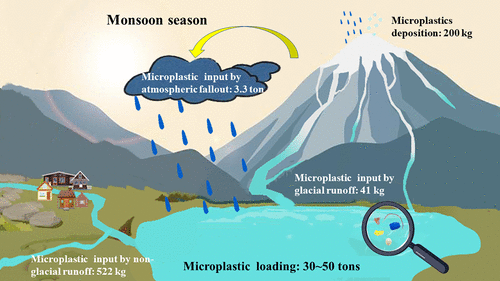当前位置:
X-MOL 学术
›
Environ. Sci. Technol.
›
论文详情
Our official English website, www.x-mol.net, welcomes your
feedback! (Note: you will need to create a separate account there.)
Microplastics in a Remote Lake Basin of the Tibetan Plateau: Impacts of Atmospheric Transport and Glacial Melting
Environmental Science & Technology ( IF 10.8 ) Pub Date : 2021-09-15 , DOI: 10.1021/acs.est.1c03227 Huike Dong 1 , Lanxiang Wang 1, 2 , Xiaoping Wang 1, 2, 3 , Li Xu 4, 5 , Mengke Chen 1, 2 , Ping Gong 1, 2, 3 , Chuanfei Wang 1, 3
Environmental Science & Technology ( IF 10.8 ) Pub Date : 2021-09-15 , DOI: 10.1021/acs.est.1c03227 Huike Dong 1 , Lanxiang Wang 1, 2 , Xiaoping Wang 1, 2, 3 , Li Xu 4, 5 , Mengke Chen 1, 2 , Ping Gong 1, 2, 3 , Chuanfei Wang 1, 3
Affiliation

|
Plastic pollution is fast becoming one of the most pressing global issues that we currently face. Remote areas, such as the polar regions and the Tibetan Plateau, are now also exposed to microplastic contamination. However, with the impact of global warming, the transport of microplastics within the glacier-lake basins in such regions remains unclear. In this work, the Nam Co Basin in the Tibetan Plateau was selected to study the characteristics of microplastics in the rain fallout, lake water, glacial runoff, and non-glacial runoff. Fiber and films were the most common microplastic morphologies in all water samples; a higher proportion (37%) of light-weighing polypropylene and small-size (50–300 μm, ∼30%) microplastics were found in the glacial runoff. Air mass trajectory analysis showed that microplastics could be transported through the atmosphere over a distance of up to 800 km. For microplastic loading in lakes, the atmospheric fallout was estimated to be 3.3 tons during the monsoon season, whereas the contributions of glacial runoff (∼41 kg) and non-glacial runoff (∼522 kg) were relatively low. For the microplastic loading in glaciers, the atmospheric deposition was ∼500 kg/yr, and the output caused by glacial melting only accounted 8% of the total atmospheric input. All these results suggested that the dominant pathway through which microplastics enter remote mountainous lake basins is atmospheric deposition, and once deposited on glaciers, microplastics will be stored for a long time. This work provides quantitative evidence elucidating the fate of microplastics in alpine lake environments.
中文翻译:

青藏高原偏远湖盆中的微塑料:大气输送和冰川融化的影响
塑料污染正迅速成为我们目前面临的最紧迫的全球问题之一。极地地区和青藏高原等偏远地区现在也受到微塑料污染。然而,随着全球变暖的影响,这些地区的冰川湖盆地内微塑料的传输尚不清楚。本工作以青藏高原纳木错盆地为研究对象,研究了降水、湖水、冰川径流和非冰川径流中微塑料的特征。纤维和薄膜是所有水样中最常见的微塑料形态;在冰川径流中发现了更高比例(37%)的轻质聚丙烯和小尺寸(50-300 μm,~30%)微塑料。气团轨迹分析表明,微塑料可以在长达 800 公里的距离内穿过大气层。对于湖泊中的微塑料负载,季风季节的大气沉降估计为 3.3 吨,而冰川径流(~41 kg)和非冰川径流(~522 kg)的贡献相对较低。对于冰川中的微塑料负载,大气沉降约为 500 kg/yr,冰川融化产生的输出仅占大气总输入的 8%。所有这些结果表明,微塑料进入偏远山区湖盆的主要途径是大气沉积,一旦沉积在冰川上,微塑料将长期储存。
更新日期:2021-10-06
中文翻译:

青藏高原偏远湖盆中的微塑料:大气输送和冰川融化的影响
塑料污染正迅速成为我们目前面临的最紧迫的全球问题之一。极地地区和青藏高原等偏远地区现在也受到微塑料污染。然而,随着全球变暖的影响,这些地区的冰川湖盆地内微塑料的传输尚不清楚。本工作以青藏高原纳木错盆地为研究对象,研究了降水、湖水、冰川径流和非冰川径流中微塑料的特征。纤维和薄膜是所有水样中最常见的微塑料形态;在冰川径流中发现了更高比例(37%)的轻质聚丙烯和小尺寸(50-300 μm,~30%)微塑料。气团轨迹分析表明,微塑料可以在长达 800 公里的距离内穿过大气层。对于湖泊中的微塑料负载,季风季节的大气沉降估计为 3.3 吨,而冰川径流(~41 kg)和非冰川径流(~522 kg)的贡献相对较低。对于冰川中的微塑料负载,大气沉降约为 500 kg/yr,冰川融化产生的输出仅占大气总输入的 8%。所有这些结果表明,微塑料进入偏远山区湖盆的主要途径是大气沉积,一旦沉积在冰川上,微塑料将长期储存。











































 京公网安备 11010802027423号
京公网安备 11010802027423号